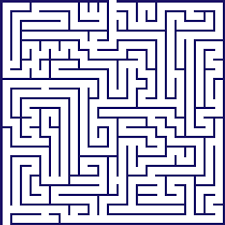
 |
CS470/570 Intro to Artificial IntelligenceChapter 3: Written Homework |
Instructions: Answers to the questions below must be presented in hardcopy, on the due date noted on the course website. All submissions must have solutions in the order listed here, and clearly labeled. A stapled submission with a neatly printing cover sheet is required. Typed answers are preferable, but clear handwritten work is acceptable.
 3.2, a, b ,d: With a few clarifications, just to make things a bit more concrete: Assume the maze is 100x100 meters in size and walls can be placed anywhere (not only at integer locations!) in this space. Walls are, however, strictly horizontal/vertical (no diagonal walls!). When it says "can move a certain distance", that just means that movement is fully variable: you can move(.001), move(2.4), move(44.56)...anything.
3.2, a, b ,d: With a few clarifications, just to make things a bit more concrete: Assume the maze is 100x100 meters in size and walls can be placed anywhere (not only at integer locations!) in this space. Walls are, however, strictly horizontal/vertical (no diagonal walls!). When it says "can move a certain distance", that just means that movement is fully variable: you can move(.001), move(2.4), move(44.56)...anything.
a) Formulate the problem means specifying the space as we learned in class: describe the "state" that will model your world, i.e., data structure to represent your world. Then describe the initial state, the goal state, the successor function, and the cost function. "How large is the search space?", of course, means "how many states are there to consider/search?"
b) Similar description as for (a), but with the new simplifications.
d) The simplications with respect to the real world could, of course, be focused either on actions or on representation of the world. List three, with at least one falling in the "action" and "model of world" categories.
3.14, all parts. It's all about understanding heuristics! Be sure to explain any answer you provide, to clearly show your reasoning.
3.15, a-d: Just asks you to show what you know about search! Surely there will be a similar problem on a midterm!
3.16, a,b,c: With the following clarifications. To really solve this, we would obviously have to knowlots about the exact dimensions/geometry of the pieces, so we could *calculate* connections. Let's abstract this away (that's what the problem statement is trying to say with "suppose they fit with zero slack"). Just assume that:
This should give you enough information to concretely envision the search problem and answer the questions!
Hint for part(c): think of what you'd need to be true of any overall solution...which might be violated in this case.
Extra credit: Part(d). Very clear explanation with concise answer here!